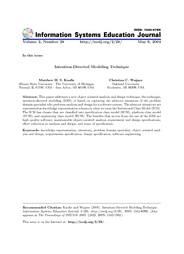Volume 2
Volume 2, Number 28 |
May 6, 2004 |

|
Matthew H. S. Kuofie
Christian C. Wagner
|
Abstract: This paper addresses a new object oriented analysis and design technique; the technique, intention-directed modeling (IDM), is based on capturing the abstract intentions of the problem domain specialist who performs analysis and design for a software system. The abstract intentions are represented as knowledge representation schema in what we term the Intentional Class Model (ICM). The ICM has classes that are classified into specification class model (SCM), platform class model (PCM), and engineering class model (ECM). The benefits that accrue from the use of the IDM are high quality software, maintainable object-oriented analysis requirement and design specifications, effort reduction in analysis and design, and reuse of specification.
Keywords: knowledge representation, intentions, problem domain specialist, object oriented analysis and design, requirements specification, design specification, software engineering
Download this issue: ISEDJ.2(28).Kuofie.pdf (Adobe PDF, 14 pages, 1069 K bytes)
Preview the contents: Kuofie.txt (ASCII txt, 33 K bytes)
Recommended Citation: Kuofie and Wagner (2004). Intention-Directed Modeling Technique. Information Systems Education Journal, 2 (28). http://isedj.org/2/28/. ISSN: 1545-679X. (A preliminary version appears in The Proceedings of ISECON 2003: §2423. ISSN: 1542-7382.)